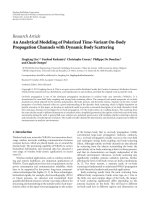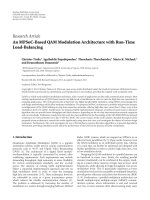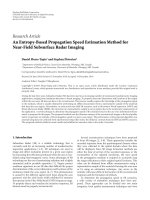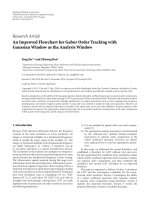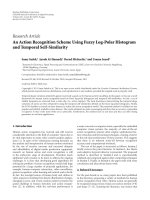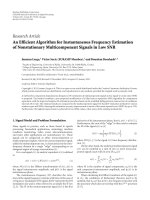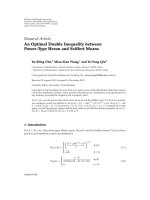Báo cáo hóa học: " Research Article An Action Recognition Scheme Using Fuzzy Log-Polar Histogram and Temporal Self-Similarity" pptx
Bạn đang xem bản rút gọn của tài liệu. Xem và tải ngay bản đầy đủ của tài liệu tại đây (6.18 MB, 9 trang )
Hindawi Publishing Corporation
EURASIP Journal on Advances in Signal Processing
Volume 2011, Article ID 540375, 9 pages
doi:10.1155/2011/540375
Research Article
An Action Recognition Scheme Using Fuzzy Log-Polar Histogram
andTemporalSelf-Similarity
Samy Sadek,
1
Ayoub Al-Hamadi,
1
Bernd Michaelis,
1
and Usama Sayed
2
1
Institute for Electronics, Signal Processing and Communications (IESK), Otto-von-Guericke University Magdeburg,
39106 Magdeburg, Germany
2
Electrical Engineer ing Department, Assiut University, Assiut, Egypt
Correspondence should be addressed to Samy Sadek,
Received 25 July 2010; Revised 26 October 2010; Accepted 8 January 2011
Academic Editor: Mark Liao
Copyright © 2011 Samy Sadek e t al. This is an open access article distributed under the Creative Commons Attribution License,
which permits unrestricted use, distribution, and reproduction in any medium, provided the original work is properly cited.
Temporal shape variations intuitively appear to provide a good cue for human activity modeling . In this paper, we lay out a novel
framework for human action recognition based on fuzzy log-polar histograms and temporal self-similarities. At first, a set of
reliable keypoints are extracted from a video clip (i.e., action snippet). The local descriptors characterizing the temporal shape
variations of action are then obtained by using the temporal self-similarities defined on the fuzzy log-polar histog rams. Finally,
the SVM classifier is trained on these features to realize the action recognition model. The proposed method is validated on two
popular and publicly available action datasets. The results obtained are quite encouraging and show that an accuracy comparable
or superior to that of the state-of-the-art is achievable. Furthermore, the method runs in real time and thus can offer timing
guarantees to real-time applications.
1. Introduction
Human action recognition has received and still receives
considerable attention in the field of computer vision due to
its vital importance to many video content analysis applica-
tions [1]. In spite of the voluminous existing literature on
the analysis and interpretation of human motion motivated
by the rise of security concerns and increased ubiquity
and affordability of digital media production equipment,
research on human action and event recognition is still
at the embryonic stage of development. Therefore much
additional work remains to be done to address the ongoing
challenges. It is clear that developing good algorithms for
solving the problem of action recognition would yield huge
potential for a large number of potential applications, for
example, human-computer interaction, video surveillance,
gesture recognition, robot learning and control, and so forth.
In fact, the nonrigid nature of human body and clothes in
video sequences resulting from drastic illumination changes,
changing in pose, and erratic motion patterns presents the
grand challenge to human detection and action recogni-
tion [2]. In addition, while the real-time performance is
a major concern in computer vision, especially for embedded
computer vision systems, the majority of state-of-the-art
action recognition systems often employ sophisticated fea-
ture extraction and/or learning techniques, creating a barrier
to the real-time performance of these systems. This suggests
that there is an inherent trade-off between recognition
accuracy and computational overhead.
The rest of the paper is structured as follows. Section 2
briefly reviews the prior literature. In Section 3, the Harris
scale-adaptive keypoint detector is presented. The proposed
method is described in Section 4 and is experimentally
validated and compared against other competing techniques
in Section 5. Finally, in Section 6, the paper ends with some
conclusions and ideas about future work.
2. Related Literature
For the past decade or so, many papers have been published
in the literature, proposing a variety of methods for human
action recognition from video. Human action can generally
be recognized using various visual cues such as motion [3–6]
and shape [7–11]. Scanning the literature, one notices that
2 EURASIP Journal on Advances in Signal Processing
a large body of work in action recognition focuses on using
keypoints and local feature descriptors [12–16]. The local
features are extracted from the region around each keypoint.
These features are then quantized to provide a discrete set
of visual words before they are fed into the classification
module. Another thread of research is concerned with ana-
lyzing patterns of motion to recognize human actions. For
instance, in [17], periodic motions are detected and classified
to recognize actions. In [4] the authors analyze the periodic
structure of optical flow patterns for gait recognition. Further
in [18], Sadek et al. present a n efficient methodology for
real-time human activity based on simple statistical features.
Alternatively, some other researchers have opted to use
both motion and shape cues. For example in [19], Bobick
and Davis use temporal templates, including motion-energy
images and motion-history images to recognize human
movement. In [20] the authors detect the similarity between
video segments using a space-time correlation model. While
in [21], Rodriguez et al. present a template-based approach
using a Maximum Average Correlation Height (MACH)
filter to capture intraclass variabilities, Jhuang et al. [22]
perform actions recognition by building a neurobiological
model using spatiotemporal gradient. In [23], actions are
recognized by training different SVM classifiers on the local
features of shape and optical flow. In parallel, a significant
amount of work is targeted at modeling and understand-
ing human motions by constructing elaborated temporal
dynamic models [24–27]. Finally, there is also a fertile and
broadly influential area of research that uses generative
topic models for modeling and recognizing action categories
based on the so-called Bag-of-Words (BoW) model. The
underlying concept of a BoW is that the video sequences
are represented by counting the number of occurrences of
descriptor prototypes, so-called visual words [28].
3. Scale-Adaptive Keypoint Detection
Harris keypoint detector [29] still retains its superior per-
formance to that of many competitors [30]. However Harris
detector is originally not scaleinvariant. The reliable Harris
detector can be adapted to be invariant to scale changes
by joining the original Harris detector with automatic
scale selection. In this case, the second moment matrix
quantifying the scale-adaptive detector is given by
μ
(
·; σ
i
, σ
d
)
= σ
2
d
g
(
·; σ
i
)
∗
⎛
⎝
L
2
x
(
·; σ
d
)
L
x
L
y
(
·; σ
d
)
L
y
L
x
(
·; σ
d
)
L
2
y
(
·; σ
d
)
⎞
⎠
,(1)
where σ
i
and σ
d
are the integration and differentiation scale,
respectively, and L
x
and L
y
are the derivatives of the scale-
space representation L(
·; σ
d
) of the image with respect to
x and y directions, respectively. The local derivatives are
computed using Gaussian kernels of size σ
d
.TheL(x, y; σ
d
)
is constructed by convolving the image with a Gaussian
kernel of size σ
d
.In[31], several differential op erators were
compared, and the experiments showed that the Laplacian
of Gaussians (LoG) finds the highest percentage of correct
characteristic scales
|LoG
(
·; σ
d
)
|=σ
2
d
L
xx
(
·; σ
d
)
+ L
yy
(
·; σ
d
)
. (2)
The eigenvalues of the matrix μ(
·; σ
i
, σ
d
) characterize the
cornerness σ of a point in a given image. The sufficiently large
values of the eigenvalues indicate the presence of a corner at
a point. The larger the values, the stronger the corner. As an
alternative way, the cornerness of a point is examined by
σ
= det
μ
(
·; σ
i
, σ
d
)
− α trace
2
μ
(
·; σ
i
, σ
d
)
,(3)
where α is a tunable parameter. Note that computing
the cornerness by (3) is computationally less expensive
and numerically stable than that of the eigenvalues. The
parameter α and the ratio σ
d
/σ
i
were experimentally set to
0.05 and 0.7, respectively. Corners are generally located at
positive local maxima in a 3
× 3neighborhood.Itmaybe
reasonable to get rid of unstable and weak maxima points,
therefore only the maxima points of values greater than
predetermined threshold are eligible to be nominated for
being corners. The nominated points are then checked for
whether their LoG response achieves local maxima over
scales. Only the points satisfying the criteria of local maxima
are keypoints.
4. Suggested Recognition Method
In this section, our method developed for recognizing
human actions in video sequences, which applies fuzzy
logic in action modeling, is introduced. A schematic block
diagram of such an action recognizer is depicted in Figure 1.
As seen from the block diagram, for each action snippet,
the keypoints are first detected by the scale-adapted detector
described in Section 3. To make the method more robust
against time warping effects, action snippets are temporally
split into a number of overlapping states defined by Gaussian
membership functions. Local features are then extracted
based on fuzzy log-polar histograms and temporal self-
similarities. Since the global features tend to be conceivably
relevant and advantageous to the current task, the final
features, so-called hybrid features, fed into classifiers are
constructed using both local and global features. Along
next subsections further details are provided concerning the
implementation aspects.
4.1. Preprocessing and Keypoint Detection. F or later successful
feature extraction and classification, it is important to
preprocess all v ideo sequences to remove noisy, erroneous,
and incomplete data and to prepare the representative
features that are suitable for knowledge generation. To wipe
off noise and weaken image distortion, all fr a mes of each
action snippet are first smoothed by Gaussian convolution
with a kernel of size 3
× 3andvarianceσ = 0.5. Then
the scale-invariant keypoints are detected using the scale-
adapted detector previously described in Section 3.The
EURASIP Journal on Advances in Signal Processing 3
x
y
t
Video sequence
Global features
SVM
Action
recognition
Fuzzy
log-polar
histograms
Temporal
self-similarities
···
Keypoint
detection
Figure 1: Block diagram of our fuzzy action recognizer.
0 5 10 15 20 25 30
0
0.2
0.4
0.6
0.8
1
t
μ
j
···
Figure 2: Gaussian membership functions used to represent the
temporal intervals, with ε
j
={0, 4, 8, }, σ = 2, and m = 3.
obtained keypoints are filtered so that under a certain
amount of additive noise, only stable and more localized
keypoints are retained. This is carried out in two steps. First,
low contrast keypoints are discarded, and second isolated
keypoints not satisfying the spatial constraints of feature
point are excluded.
4.2. Local Feature Extraction. Feature extraction forms the
cornerstone of any action recognition procedure, but is also
the most challenging and time-consuming part. The next
subsections describe in more detail how such features are
defined and extracted.
···
h
1
h
2
h
s
Time
Figure 3: Fuzzy log-polar histograms representing the spatio-
temporal shape contextual information of action snippet.
4.2.1. Fuzzy Log-Polar Histograms. First, we temporally par-
tition an action snippet into several segments. These seg-
ments are defined by linguistic intervals. Gaussian functions
are used to describe these intervals, which are given by
μ
j
t; ε
j
, σ,m
=
e
−(1/2)|(t−ε
j
)/σ|
m
, j = 1, 2, , s,(4)
where ε
j
, σ,andm are the center, width, and fuzzification
factor, respectively, while s is the total number of temporal
segments. The membership functions defined above are
chosen to be of identical shape on condition that their
sum is equal to one at any instance of time as shown in
Figure 2. It is thus seen that by using such fuzzy functions,
not only can local temporal features be extracted precisely,
4 EURASIP Journal on Advances in Signal Processing
the performance decline resulting from time warping effects
can also be reduced or eliminated. To extract now the local
features of the shape representing action at an instance of
time, our own temporal localized shape context is defined,
inspired by the basic idea of shape context. Compared with
the shape context [32], our localized shape context differs
in meaningful ways. The idea behind a modified shape
context is based on computing rich descr iptors for fewer
keypoints. The shape descriptors presented here calculate the
log-polar histograms on condition that they are invariant
to simple transforms like scaling, rotation, and translation.
The histograms are normalized for all affine transforms as
well. Furthermore the shape context is reasonably extended
by combining local descriptors with fuzzy memberships
functions and temporal self-similarities paradigms. Human
action is generally composed of a sequence of poses over
time. Reasonable estimate of a pose can be constructed using
a small set of keypoints. Ideally, such points are distinctive,
persist across minor variation of shapes, robust to occlusion,
and do not require segmentation. Let B be the set of
sampled keypoints
{(x
i
, y
i
)}
n
i
=1
representing an action at an
instance of time t
i
, then for each keypoint p
i
, the log-polar
coordinates ρ
i
and η
i
are given by
ρ
i
= log
(
x
i
− x
c
)
2
+
y
i
− y
c
2
,
η
i
= arctan
y
i
− y
c
x
i
− x
c
, i = 1, 2, , n,
(5)
where (x
c
, y
c
) is the center of mass of B, which is invariant to
image translation, scaling, and rotation. For this the angle η
i
is computed with respect to a horizontal line passing through
the center of mass. Now, to calculate the modified version
of shape context, a log-polar histogram is overlaid on the
shape as shown in Figure 3. Thus the histogram representing
the shape context of action is constructed for each temporal
phase j by
h
j
(
k
1
, k
2
)
=
ρ
i
∈ bin
(
k
1
)
,
η
i
∈ bin
(
k
2
)
μ
j
(
t
i
)
, j
= 1, 2, , s. (6)
By applying a simple linear transformation on the indices k
1
and k
2
, the 2D histograms are converted into 1D as follows:
h
j
(
k
)
= h
j
k
1
dη + k
2
, k = 0, 1, , dρdη − 1. (7)
The resulting 1D histograms are then normalized to achieve
robustness to scale variations. The normalized histograms
obtained can be used as shape contextual information for
classification and matching. Many approaches in various
computer vision applications directly combine these his-
tograms to get one histogram per video and classify it using
any classification algorithm. In contrast, in this paper, we
aim to enrich these histograms with self-similarity analysis
after using a suitable distance function to measure similarity
(more precisely dissimilarity) between each pair of these
histograms. This is of most importance to accurately dis-
criminate between temporal variations of different actions.
4.2.2. Temporal Self-Similarities of Action Snippet. Video
analysis is seldom carried out directly on row video data.
Instead feature vectors extracted from small portions of
video (i.e., frames) are used. Thus the similarity between two
video segments is measured by the similarity between their
corresponding feature vectors. For comparing the similarity
between two vectors, one can use several metrics such as
Euclidean metric, Cosine metric, and Mahalanobis metric,
and so forth. Whilst such metrics may have some intrinsic
merits, they have some limitations to be used with our
approach because we might care more about identifying
the spatial locations of significant changes over time rather
than the actual magnitudes, which is of main concern
in applications such as action recognition. Therefore, we
propose a new similarity (or more precisely, dissimilarity)
metric in which the spatial changes are considered. Such
metric is defined as
ρ
−→
μ ,
−→
v
=
arg max
k
(
u
k
− v
k
)
2
u
k
+ v
k
(8)
which can be easily normalized to unity, if desired. To reveal
the inner structure of human action in video clip, second
statistical moments (i.e., mean and var iance) might seem to
be not quite appropriate. Instead self-similarity analysis is of
immense relevance to this task, which adapts this approach.
Formally speaking, given a sequence of fuzzy histograms
H
= (h
1
, h
2
, , h
m
) that represent m time slices of an action
snippet, then the temporal self-similarity matrix is defined
by
S
=
s
ij
m
i, j
=1
=
⎛
⎜
⎜
⎜
⎜
⎜
⎜
⎜
⎝
0 s
12
··· s
1m
s
21
0 ··· s
2m
.
.
.
.
.
.
.
.
.
.
.
.
s
m1
s
m2
··· 0
⎞
⎟
⎟
⎟
⎟
⎟
⎟
⎟
⎠
,(9)
where s
ij
= ρ(h
i
, h
j
), i, j = 1, 2, , m. The main diagonal
elements are zero because s(h
i
, h
i
) = 0 ∀i. Meanwhile,
because s
ij
= s
ji
, S is a symmetric matrix.
4.3. Fusing Global Features and Local Features. It emerges
from the discussion in the previous subsections that the
features extracted u sing fuzzy log-polar histograms and tem-
poral self-similarities have been highlighted. Such features
obtained at each temporal stage are considered as temporally
local features, while the features that are extracted along the
entire motion are regarded as temporally global features.
Though we should note that each of the two types of features
is spatially local. Global features have previously proven to be
successful in many applications of object recognition. This
encourages us to extend the idea to the temporally global
features and to fuse global features and local features to
form the final SVM classifier. All global features extracted
herein are based on calculating the center of gravity
−→
m(t) that
EURASIP Journal on Advances in Signal Processing 5
ε
1
ε
2
βx + β
0
= +1
βx + β
0
= 0
βx + β
0
=−1
Figure 4: Generalized optimal separating hyperplane.
delivers the center of motion. Thus the global features
−→
F (t)
describing the distribution of motion are given by
−→
F
(
t
)
=
Δ
−→
m
(
t
)
Δt
,
−→
m
(
t
)
=
1
n
n
i=1
p
i
(
t
)
. (10)
Such features are very informative not only about the type of
motion (e.g., translational or oscillatory), but also about the
rate of motion (i.e., velocity). With these features, it would be
able to distinguish, for example, between an action in which
motion occurs over a relatively large area (e.g., running) and
an action localized in a smaller region, where only small parts
are in motion (e.g., boxing). Hence significant improvements
in recognition performance are expected to be achieved by
fusing global and local features.
4.4. SVM Classification. In this section, we formulate the
action recognition task as a multiclass learning problem,
where there is one class for each action, and the goal
is to assign an action to an individual in each video
sequence. There are various supervised learning algorithms
by which an action recognizer can be trained. Support
Vector Machines (SVMs) are used in our framework due
to their outstanding generalization capability and reputation
of a highly accurate paradigm. SVMs [33] are based on
the structure risk minimization principle from computa-
tional theory and are a solution to data overfitting in
neural networks. Originally, SVMs were designed to handle
dichotomic classes in a higher-dimensional space where a
maximal separating hyperplane is created. On each side of
this hyperplane, two parallel hyperplanes are conducted.
Then SVM attempts to find the separating hyperplane that
maximizes the distance between the two parallel hyperplanes
(see Figure 4). Intuitively, a good separation is achieved by
the hyperplane having the largest distance. Hence the larger
the margin the lower the generalization error of the classifier.
More formally, leting D
={(x
i
, y
i
) | x
i
∈ R
d
, y
i
∈
{−
1, +1}} be a training dataset, Vapnik [33] show that this
problem is best addressed by allowing some examples to
violate the margin constraints. These potential violations
are formulated using some positive slack variables ξ
i
and a
penalty parameter C
≥ 0 that penalize the margin violations.
Table 1: Confusion matrix obtained on KTH dataset.
Action Walking Running Jogging Waving Clapping Boxing
walking 0.98 0.00 0.02 0.00 0.00 0.00
running 0.00 0.97 0.03 0.00 0.00 0.00
jogging 0.05 0.11 0.83 0.00 0.01 0.00
waving 0.00 0.00 0.00 0.94 0.00 0.06
clapping 0.00 0.00 0.00 0.00 0.92 0.08
boxing 0.00 0.00 0.00 0.00 0.01 0.99
Table 2: Comparison with other methods done using KTH dataset.
Method Accuracy
Our method 93.6%
Liu and shah [15] 92.8%
WangandMori[35] 92.5%
Jhuang et al. [22] 91.7%
Rodriguez et al. [21] 88.6%
Rapantzikos et al. [36] 88.3%
Doll
´
ar et al. [37] 81.2%
Ke et al. [12] 63.0%
Thus the optimal separating hyperplane is determined by
solving the following QP problem:
min
β,β
0
1
2
β
2
+ C
i
ξ
i
(11)
subject to (y
i
(x
i
, β + β
0
) ≥ 1 − ξ
i
∀i) ∧ (ξ
i
≥ 0 ∀i).
Geometrically, β
∈ R
d
is a vector going through the origin
point and perpendicular to the separating hyperplane. The
offset parameter β
0
is added to allow the margin to increase,
and not to force the hyperplane to pass through the origin
that restricts the solution. For computational purposes it is
more convenient to solve SVM in its dual formulation. This
can be accomplished by forming the Lagrangian and then
optimizing over the Lagrange multiplier α. The resulting
decision function has weight vector β
=
i
α
i
x
i
y
i
,0≤ α
i
≤
C. The instances x
i
with α
i
> 0aretermedsupport vectors,
as they uniquely define the maximum margin hyperplane. In
our approach, several classes of actions are created. Several
one-versus-all SVM classifiers are trained using the features
extracted from the action snippets in the training dataset.
The up diagonal elements of the temporal similarity matrix
representing the features are first transformed into plain
vectors based on the element scan order. All feature vectors
are then fed into the SVM classifiers for the final decision.
5. Experiments
We present our experimental results in this section. The
experiments presented here are divided into two parts. For
each part, we summarize the experimental setup and the
dataset we used. In this work, two popular and publicly
available action datasets, namely, KTH dataset [16]and
Weizmann [34], were used to demonstrate and validate our
proposed approach. To assess the feasibility/reliability of the
approach, the results obtained from both experiments were
6 EURASIP Journal on Advances in Signal Processing
Box Wave Clap
Walk Jug
Run
Figure 5: Example sequences from the KTH action dataset.
Side Wave 2 Wave 1BendJack
Walk RunJump Skip
Pjump
Figure 6: Sample sequences from the Weizmann action dataset.
Table 3: Confusion matrix obtained on Weizmann dataset.
Action wave2 wave1 walk skip side run pjump jump jack bend
wave2 1.00 0.00 0.00 0.00 0.00 0.00 0.00 0.00 0.00 0.00
wave1 0.00 1.00 0.00 0.00 0.00 0.00 0.00 0.00 0.00 0.00
walk 0.00 0.00 1.00 0.00 0.00 0.00 0.00 0.00 0.00 0.00
skip 0.00 0.00 0.00 0.89 0.00 0.00 0.00 0.11 0.00 0.00
side 0.00 0.00 0.00 0.00 1.00 0.00 0.00 0.00 0.00 0.00
run 0.00 0.00 0.00 0.00 0.00 1.00 0.00 0.00 0.00 0.00
pjump 0.00 0.00 0.11 0.00 0.00 0.00 1.00 0.00 0.00 0.00
jump 0.00 0.00 0.00 0.00 0.00 0.11 0.00 0.89 0.00 0.00
jack 0.00 0.00 0.00 0.00 0.00 0.00 0.00 0.00 1.00 0.00
bend 0.00 0.00 0.00 0.00 0.00 0.00 0.00 0.00 0.00 1.00
EURASIP Journal on Advances in Signal Processing 7
Table 4: Comparison with other recent methods on Weizmann
dataset.
Method Accuracy
Our method 97.8%
Fathi and Mori [42] 100%
Bregonzio et al. [38] 96.6%
Zhang et al. [39] 92.8%
Niebles et al. [40] 90.0%
Doll
´
ar et al. [37] 85.2%
Kl
¨
aser et al. [41] 84.3%
then compared with those reported by other investigators in
similar studies.
5.1. Experiment-1. We conducted the first experiment using
the KTH dataset in which a total of 2391 sequences are
involved. The sequences include six types of human actions
(i.e., walking, jogging, r unning, boxing, hand waving and
hand clapping). Each of these actions is performed by
a total of 25 individuals in four different settings (i.e.,
outdoors, outdoors with scale variation, outdoors with
different clothes, and indoors). All action sequences were
taken with a static camera at 25 fps frame rate and a
spatial resolution of 160
× 120 pixels over homogeneous
backgrounds. Although the KTH dataset is actually not a
real-world dataset and thus not so much challenging, there
are, to the best of our knowledge, only very few similar
datasets already available in the literature with sequences
acquired on different environments. An example sequence
for each action from the KTH dataset is shown in Figure 5.
In order to prepare the simulation and to provide an
unbiased estimation of the generalization abilities of the
classification process, we partition the sequences for each
action into a training set (two thirds) and a test set (one
third). This was done such that both sets contained data
from all the sequences in the dataset. The SVMs were trained
on the training set while the ev aluation of the recognition
performance was performed on the test set. Table 1 shows
the confusion matrix that depicts the recognition results
obtained on KTH dataset. As follows from the figures
tabulated in Tabl e 1, most actions are correctly classified.
Additionally, there is a high distinction between arm ac tions
and leg actions. Most of the mistakes where confusions occur
are between “jogging” and “running” actions and between
“boxing” and “clapping” actions. This intuitively seems to
be reasonable due to the fact of high similarity between
each pair of these actions. To assess the reliability of the
proposed approach, our results obtained for this experiment
are compared with those obtained by other authors in similar
studies (see Table 2). From this comparison, it turns out
that our method performs competitively with other state-of-
the-art methods and its results are compared favorably with
previously published results. Here we would like to contend
that all the methods that we compared our method with
have used similar experimental setups, thus the comparison
is most unbiased.
5.2. Experiment-2. This experiment was conducted using the
Weizmann action dataset provided by Blank et al. [34]in
2005. This dataset contains a total of 90 video clips (i.e.,
5098 frames) performed by 9 individuals. Each video clip
contains one person performing an action. There are 10
categories of action involved in the dataset, namely, walking,
running, jumping, jumping in place, bending, jacking, skipping,
galloping-sideways, one-hand-wav ing, and two-hand-waving.
Typically, all the clips in the dataset are sampled at 25 Hz
and last about 2 seconds with image frame size of 180
×
144. Figure 6 shows a sample image for each actions in the
Weizmann dataset. Again, in order to provide an unbiased
estimate of the generalization abilities of our method, the
leave-one-out cross-validation technique was used in the
validation process. As the name suggests, this involves using
a group of sequences from a single subject in the original
dataset as the testing data and the remaining sequences as
the training data. This is repeated such that each group
of sequences in the dataset is used once as the validation.
More specifically, the sequences of 8 subjects were used
for training, and the sequences of the remaining subject
were used for validation data. Then the SVM classifiers
with Gaussian radial basis function kernel are trained on
the training set, while the evaluation of the recognition
performance is performed on the test set. In Table 3, the
recognition results obtained on the Weizmann dataset are
summarized in a confusion matrix, where correct responses
define the main diagonal.
From the figures in the matrix, a number of points can
be drawn. The majority of actions are correctly classified.
An average recognition rate of 97.8% is achieved with our
proposed method. What is more, there is a clear distinction
between arm actions and leg actions. The mistakes where
confusions occur are only between skip and jump actions
and between jump and run actions. This is also due to
the high closeness or similar ity among the actions in each
pair of these actions. Once more, in order to quantify the
effectiveness of the proposed method, the obtained results
are compared qualitatively with those obtained previously
by other investigators. The outcome of this comparison
is presented in Ta ble 4. In light of this comparison, one
can see that the proposed method is competitive with
other state-of-the-art methods. It is worthwhile to mention
here that all the methods [37–41] that we compared our
method with, except the method proposed in [42], have
used similar experimental setups, thus the comparison seems
to be meaningful and fair. A final remark concerns the
computational time performance of the approach. In both
experiments, the proposed action recognizer runs at 28 fps
on average (using a 2.8 GHz Intel dual core machine with
4 GB of RAM, running Microsoft Windows 7 Professional).
This suggests that the approach is very amenable to working
with real-time applications and embedded systems.
6. Conclusion and Future Work
In this paper, such a fuzzy approach to human activit y
recognition based on keypoint detection has been pro-
posed. Although our model might seem to be similar to
8 EURASIP Journal on Advances in Signal Processing
previous models of visual recognition, it differs substantially
in some important aspects resulting in a considerably
improved performance. Most importantly, in contrast to the
motion features employed previously, local shape contextual
information in this model is obtained through fuzzy log-
polar histograms and local self-similarities. Additionally, the
incorporation of fuzzy concepts allows the model to be most
robust to shape deformations and time wrapping effects. The
obtained results are either comparable to or surpass previous
results obtained through much more sophisticated and
computationally complex methods. Finally the method can
offer timing guarantees to real-time applications. However it
would be advantageous to explore the empirical validation
of the method on more complex realistic datasets presenting
many technical challenges in data handling such as object
articulation, occlusion, and significant background clutter.
Certainly, this issue is very important and will be at the
forefront of our future work.
Acknowledgment
This work is supported by the Transregional Collaborative
Research Centre SFB/TRR 62 “Companion-Te chnology for
Cognitive Technical Systems” funded by DFG and Bernstein-
Group (BMBF/FKZ: 01GQ0702).
References
[1] T. B. Moeslund, A. Hilton, and V. Kr
¨
uger, “A survey of
advances in vision-based human motion capture and analy-
sis,” Computer Vision and Image Understanding, vol. 104, no.
2-3, pp. 90–126, 2006.
[2]B.Chakraborty,A.D.Bagdanov,andJ.Gonz
`
alez, “Towards
real-time human action recognition,” in Proceedings of the 4th
Iberian Conference on Pattern Recognition and Image Analysis
(IbPRIA ’09), vol. 5524 of Lecture Notes in Computer Science,
pp. 425–432, June 2009.
[3]A.A.Efros,A.C.Berg,G.Mori,andJ.Malik,“Recognizing
action at a distance,” in Proceedings of the 9th IEEE Interna-
tional Conference on Computer Vision (ICCV ’03), pp. 726–733,
October 2003.
[4] L. Little and J. E. Boyd, “Recognizing people by their gait: the
shape of motion,” International Journal of Computer Vision,
vol. 1, no. 2, pp. 1–32, 1998.
[5] YU. G. Jiang, C. W. Ngo, and J. Yang, “Towards optimal
bag-of-features for object categorization and semantic video
retrieval,” in Proceedings of the 6th ACM International Confer-
ence on Image and Video Retrieval (CIVR ’07), pp. 494–501,
July 2007.
[6] S. Sadek, A. Al-Hamadi, B. Michaelis, and U. Sayed, “Towards
robust human action retrieval in video,” in Proceedings of the
British Machine Vision Conference (BMVC ’10),Aberystwyth,
UK, 2010.
[7] J. Sullivan and S. Carlsson, “Recognizing and tracking human
action,” in Proceedings of the 7th European Conference on Com-
puter Vision (ECCV ’02), vol. 1, pp. 629–664, Copenhagen,
Denmark, May-June 2002.
[8] W. L. Lu, K. Okuma, and J. J. Little, “Tracking and recognizing
actions of multiple hockey players using the boosted particle
filter,” Image and Vision Computing, vol. 27, no. 1-2, pp. 189–
205, 2009.
[9] S. Sadek, A. Al-Hamadi, B. Michaelis, and U. Sayed, “Human
activity recognition: a scheme using multiple cues,” in Proceed-
ings of the 6th International, Symposium on Visual Computing
(ISVC ’10), vol. 6454 of Lecture Notes in Computer Science,pp.
574–583, Las Vegas, Nev, USA, November-December 2010.
[10] C. Thurau and V. Hlav
´
a
ˇ
c, “Pose primitive based human action
recognition in videos or still images,” in Proceedings of the 26th
IEEE Conference on Computer Vision and Pattern Recognition
(CVPR ’08), June 2008.
[11] S. Sadek, A. Al-Hamadi, B. Michaelis, and U. Sayed, “Human
activity recognition via temporal moment invariants,” in
Proceedings of IEEE Symposium on Signal Processing and
Information Technology (ISSPIT ’10), 2010.
[12] Y. Ke, R. Sukthankar, and M. Hebert, “Efficient visual event
detection using volumetric features,” in Proceedings of the 10th
IEEE International Conference on Computer Vision (ICCV ’05),
pp. 166–173, October 2005.
[13] A. Kovashka and K. Grauman, “Learning a hierarchy of
discriminative space-time neighborhood features for human
action recognition,” in Proceedings of IEEE Computer Society
Conference on Computer Vision and Pattern Recognition (CVPR
’10), pp. 2046–2053, San Francisco, Calif, USA, June 2010.
[14] A. Gilbert, J. Illingworth, and R. Bowden, “Fast realistic
multi-action recognition using mined dense spatio-temporal
features,” in Proceedings of the 12th International Conference on
Computer Vision (ICCV ’09), pp. 925–931, October 2009.
[15] J. Liu and M. Shah, “Learning human actions v i a information
maximization,” in Proceedings of the 26th IEEE Conference on
Computer Vision and Pattern Recognition (CVPR ’08)
, June
2008.
[16] I. Laptev and P. P
´
erez, “Retrieving actions in movies,” in
Proceedings of the 11th IEEE International Conference on
Computer Vision (ICCV ’07), October 2007.
[17] R. Cutler and L. S. Davis, “Robust real-time periodic motion
detection, analysis, and applications,” IEEE Transactions on
Pattern Analysis and Machine Intelligence, vol. 22, no. 8, pp.
781–796, 2000.
[18] S. Sadek, A. Al-Hamadi, B. Michaelis, and U. Sayed, “An effi-
cient method for real-time activit y recognition,” in Proceedings
of the International Conference on Soft Computing and Pattern
Recognition (SoCPaR ’10), France, 2010.
[19] A. F. Bobick and J. W. Davis, “The recognition of human
movement using temporal templates,” IEEE Transactions on
Pattern Analysis and Machine Intelligence, vol. 23, no. 3, pp.
257–267, 2001.
[20] E. Shechtman and M. Irani, “Space-time behavior based cor-
relation,” in Proceedings of IEEE Computer Society Conference
on Computer Vision and Pattern Recognition (CVPR ’05),pp.
405–412, June 2005.
[21] M. D. Rodriguez, J. Ahmed, and M. Shah, “Action MACH: a
spatio-temporal maximum average correlation height filter for
action recognition,” in Proceedings of the 26th IEEE Conference
on Computer Vision and Pattern Recognition (CVPR ’08), June
2008.
[22] H. Jhuang, T. Serre, L. Wolf, and T. Poggio, “A biologically
inspired system for action recognition,” in Proceedings of the
11th IEEE International Conference on Computer Vision (ICCV
’07), October 2007.
[23] K. Schindler and L. Van Gool, “Action snippets: how many
frames does human action recognition require?” in Proceed-
ings of the 26th IEEE Conference on Computer Vision and
Pattern Recognition (CVPR ’08), June 2008.
[24] X. Feng and P. Perona, “Human action recognition by
sequence of movelet codewords,” in Proceedings of the 1st
EURASIP Journal on Advances in Signal Processing 9
International Symposium on 3D D ata Processing Visualization
and Transmission, pp. 717–721, 2002.
[25] N. Ikizler and D. Forsyth, “Searching video for complex
activities with finite state models,” in Proceedings of IEEE
Computer Society Conference on Computer Vision and Pattern
Recognition (CVPR ’07), June 2007.
[26] B. Laxton, J. Lim, and D. Kriegmant, “Leveraging temporal,
contextual and ordering constraints for recognizing complex
activities in video,” in Proceedings of IEEE Computer Society
Conference on Computer Vision and Pattern Recognition (CVPR
’07), June 2007.
[27] N. Oliver, A. Garg, and E. Horvitz, “Layered representations
for learning and inferring office activity from multiple sensory
channels,” Computer Vision and Image Understanding, vol. 96,
no. 2, pp. 163–180, 2004.
[28] D. M. Blei and J. D. Lafferty, “Correlated topic models,” in
Advances in Neural Information Processing Systems (NIPS), vol.
18, pp. 147–154, 2006.
[29] C. Harris and M. Stephens, “A combined corner and edge
detector,” in Proceedings of the 4th Alvey Vision Conference,pp.
147–151, 1988.
[30] C. Schmid, R. Mohr, and C. Bauckhage, “Evaluation of interest
point detectors,” International Journal of Computer Vision, vol.
37, no. 2, pp. 151–172, 2000.
[31] K. Mikolajczyk and C. Schmid, “Scale & affine invariant
interest point detectors,” International Journal of Computer
Vision, vol. 60, no. 1, pp. 63–86, 2004.
[32] S. Belongie, J. Malik, and J. Puzicha, “Shape matching and
object recognition using shape contexts,” IEEE Transactions on
Pattern Analysis and Machine Intelligence, vol. 24, no. 4, pp.
509–522, 2002.
[33] V. Vapnik, The Nature of Statistical Learning Theory, Springer,
New York, NY, USA, 1995.
[34] M. Blank, L. Gorelick, E. Shechtman, M. Irani, and R. Basri,
“Actions as space-time shapes,” in Proceedings of the 10th IEEE
International Conference on Computer Vision (ICCV ’05),pp.
1395–1402, October 2005.
[35] Y. Wang and G. Mori, “Max-Margin hidden conditional
random fields for human action recognition,” in Proceedings
of IEEE Computer Society Conference on Computer Vision and
Pattern Recognition Workshops (CVPR ’09), pp. 872–879, June
2009.
[36] K. Rapantzikos, Y. Avrithis, and S. Kollias, “Dense saliency-
based spatiotemporal feature points for action recognition,” in
Proceedings of IEEE Computer Society Conference on Computer
Vision and Pattern Recognition Workshops (CVPR ’ 09),pp.
1454–1461, June 2009.
[37] P. Doll
´
ar, V. Rabaud, G. Cottrell, and S. Belongie, “Behavior
recognition via sparse spatio-temporal features,” in Proceed-
ings of the 2nd Joint IEEE International Workshop on Visual
Surveillance and Performance Evaluation of Tracking and
Surveillance (VS-PETS ’05), pp. 65–72, October 2005.
[38] M. Bregonzio, S. Gong, and T. Xiang, “Recognising action as
clouds of space-time interest points,” in Proceedings of IEEE
Computer Society Conference on Computer Vision and Pattern
Recognition Workshops (CVPR ’09), pp. 1948–1955, June 2009.
[39] Z. Zhang, Y. Hu, S. Chan, and L. T. Chia, “Motion context:
a new representation for human action recognition,” in
Proceedings of the 10th European Conference on Computer
Vision (ECCV ’08), vol. 5305 of Lecture Notes in Computer
Science, no. 4, pp. 817–829, October 2008.
[40] J. C. Niebles, H. Wang, and LI. Fei-Fei, “Unsupervised learning
of human action categories using spatial-temporal words,”
International Journal of Computer Vision,vol.79,no.3,pp.
299–318, 2008.
[41] A. Kl
¨
aser, M. Marszaek, and C. Schmid, “A spatio-temporal
descriptor based on 3D gradients,” in Proceedings of the British
Machine Vision Conference (BMVC ’08), 2008.
[42] A. Fathi and G. Mori, “Action recognition by learning
mid-level motion features,” in Proceedings of the 26th IEEE
Conference on Computer Vision and Pattern Recognition (CVPR
’08), June 2008.



